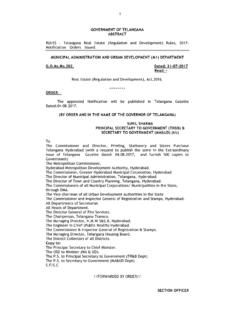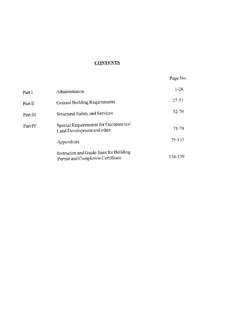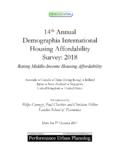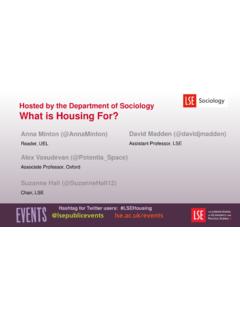Transcription of KPMG-NAREDCO Urban housing shortage in India
1 REAL ESTATE AND CONSTRUCTIONB ridging the Urban housing shortage in India 2012 KPMG, an Indian Registered Partnership and a member firm of the KPMG network of independent member firms affiliated with KPMG International Cooperative ( KPMG International ), a Swiss entity. All rights from KPMG in IndiaBy 2050, 900 million people will be added to Indian cities1. The rapid pace of urbanisation owing to the rural Urban migration is putting a strain on the Urban infrastructure in these cities. As Urban development takes place, a growing concern for India s Urban planners is the massive Urban housing shortage plaguing the country. The shortage , prominent within the EWS (economically weaker sections) and LIG (lower income groups), is estimated at million households in 20122. A thrust on encouraging private sector participation in affordable housing , traditionally the domain of the Government, could provide the answer to India s Urban housing predicament.
2 But as things stand, affordable housing remains a challenging proposition for developers. Issues continue to persist in land availability and pricing, project approval processes and other areas which make low cost housing projects uneconomical for private developers. Making affordable housing work in India necessitates the active involvement of all the stakeholders concerned. Radical thinking on the part of the Government can provide the much needed fillip to affordable housing development in the country. Steps such as establishment of a single window clearance system, formulation of innovative micro mortgage lending models and tax subsidies would encourage private sector involvement. The developers, on their part, need to adopt innovative and low-cost technologies which could enable them to deliver affordable houses quickly and cost effectively. Given this backdrop, the study: Bridging the Urban housing shortage in India , a joint effort of NAREDCO and KPMG in India , discusses at length on the rising trend of urbanisation in India and the looming Urban housing shortage .
3 It further deliberates on the constraints faced by real estate developers in their bid to bridge the gap through affordable housing . Finally, the study dwells on the measures that can be taken by various stakeholders which can make housing affordable for the Urban masses in India . Richard RekhyCEO, KPMG in India1 Urban Infrastructure in India , FICCI, October 20112 Report of the Technical Urban Group (TG-12) on Urban housing shortage 2012-17, Ministry of housing and Urban Poverty Alleviation, September 2012 Navin RahejaPresident, NAREDCO 2012 KPMG, an Indian Registered Partnership and a member firm of the KPMG network of independent member firms affiliated with KPMG International Cooperative ( KPMG International ), a Swiss entity. All rights from NAREDCOI ndia s Urban population registered a decadal growth of 32 percent rising from 285 million to 377 million between 2001 and 20113.
4 It is opined that this trend is likely to persist on the back of robust economic development across the country. Given this scenario, it becomes critical to fill the existing gaps in the country s strained Urban infrastructure and in particular, housing . Primarily, it would be important to address the need in the EWS (economically weaker sections) and LIG (lower income groups), which currently account for 95 percent4 of Urban housing shortage in the country. Furthermore, 10 Indian States contribute to three-fourths of the Urban housing By providing affordable housing , the real estate sector can play a pivotal role in Urban development of these states as well as the country. However, as things stand, the real estate sector faces considerable headwinds. Rising cost pressures and a difficult regulatory scenario are among the primary concerns. State and Central Government support in the form of liberal regulations and inclusive growth policies could provide the means to harnessing the full potential of affordable housing in the country.
5 The study prepared by National Real Estate Development Council, the apex body of real estate industry, in conjunction with KPMG in India details the constraints for affordable housing and suggests viable and practical solutions which could help the country in mending the gap. 3 Census of India 2011; KPMG in India analysis4 Report of the Technical Urban Group (TG-12) on Urban housing shortage 2012-17, Ministry of housing and Urban Poverty Alleviation, September 20125 Report of the Technical Urban Group (TG-12) on Urban housing shortage 2012-17, Ministry of housing and Urban Poverty Alleviation, September 2012; KPMG in India analysis 2012 KPMG, an Indian Registered Partnership and a member firm of the KPMG network of independent member firms affiliated with KPMG International Cooperative ( KPMG International ), a Swiss entity. All rights | Bridging the Urban housing shortage in IndiaUrban housing shortage in India6 Census of India 2011 7 Urban Infrastructure in India , FICCI, October 2011 8 Opportunities in an Urbanizing World, Credit Suisse, April 2012 Urban population set to outgrow overall population growthIndia s Urban population has grown at a CAGR of percent over 2001-2011, resulting in an increase in the urbanization rate from percent to Out of India s billion population, 377 million people are Urban The Federation of Indian Chambers of Commerce (FICCI) estimates that by 2050, the country s cities would witness a net increase of 900 million Furthermore, over 2012-2050, the pace of urbanization is likely to increase at a CAGR of percent double than that of Urbanization Growth in IndiaSource.
6 Census of India 2011 2012 KPMG, an Indian Registered Partnership and a member firm of the KPMG network of independent member firms affiliated with KPMG International Cooperative ( KPMG International ), a Swiss entity. All rights the Urban housing shortage in India | 2 With the country s agriculture sector having a limited absorption capacity, majority of the growth in urbanisation is expected to be a consequence of rural-to- Urban migration. Post economic liberalization, India s manufacturing and services sector has seen an influx in employment from the rural youth. With the country expected to witness rapid industrialization, the trend of migration from rural to Urban areas is likely to continue. Looming housing shortage in Urban IndiaGrowing concentration of people in Urban areas has resulted in an increase in the number of people living in slums and squatter settlements.
7 Skyrocketing prices of land and real estate in Urban areas have induced the poor and the economically weaker sections of the society to occupy the marginal lands typified by poor housing stock, congestion and obsolescence. It is apparent that substantial housing shortage looms in Urban India and a wide gap exists between the demand and supply of housing , both in terms of quantity and to a report submitted by a technical committee to the Ministry of housing and Urban Poverty Alleviation (MHUPA), India s Urban housing shortage is estimated at nearly million households in Besides those living in obsolescent houses, 80 percent9 of these households are living in congested houses and are in requirement of new houses. The report also highlights that nearly one million households are living in non-serviceable katcha houses, while over half a million households are in homeless Report of the Technical Urban Group (TG-12) on Urban housing shortage 2012-17, Ministry of housing and Urban Poverty Alleviation, September 2012 2011 KPMG, an Indian Partnership and a member firm of the KPMG network of independent member firms affiliated with KPMG International Cooperative ( KPMG International ), a Swiss entity.
8 All rights reserved. 2012 KPMG, an Indian Registered Partnership and a member firm of the KPMG network of independent member firms affiliated with KPMG International Cooperative ( KPMG International ), a Swiss entity. All rights | Bridging the Urban housing shortage in IndiaOf the total Urban housing shortage , nearly 62 percent houses are self-owned, while 38 percent families live in rented homes. The below table illustrates the break-up of housing shortage in both these categories in Urban India :TenureNumber of families living in old housesFamilies living in katcha housesNumber of families living in congestionFamilies without homesTotal Urban housing shortageSelf-owned1,395,735770,8179,188, 746326,43011,681,728 Rented870,417219,1835,700,019203,5706,99 3,189 Source: Report of the Technical Urban Group (TG-12) on Urban housing shortage 2012-17, Ministry of housing and Urban Poverty Alleviation, September 201210 States contribute to three-fourths of the Urban housing shortageThe State-wise data shows a mixed picture where both developed as well as less developed states have families living in poor housing conditions.
9 Uttar Pradesh has a housing shortage of over three million homes followed by Maharashtra ( mn), West Bengal ( mn), Andhra Pradesh ( mn) and Tamil Nadu ( mn). The top 10 states, in terms of Urban housing shortage , contribute to million or 76 percent of housing 10 Report of the Technical Urban Group (TG-12) on Urban housing shortage 2012-17, Ministry of housing and Urban Poverty Alleviation, September 2012 Urban housing shortage 2012 Note: *Katcha refers to houses made of local products like bamboo, mud etcSource: Report of the Technical Urban Group (TG-12) on Urban housing shortage 2012-17, Ministry of housing and Urban Poverty Alleviation, September 2012 State-wise housing shortage in 2012 (Fig in million)Source: Report of the Technical Urban Group (TG-12) on Urban housing shortage 2012-17, Ministry of housing and Urban Poverty Alleviation, September 2012 2012 KPMG, an Indian Registered Partnership and a member firm of the KPMG network of independent member firms affiliated with KPMG International Cooperative ( KPMG International ), a Swiss entity.
10 All rights the Urban housing shortage in India | 4 Affordable housing The order of the dayIndia s Urban housing shortage is being primarily driven by the EWS and LIG categories. However, majority of the housing supply that has been built across Urban India is beyond the affordability of the EWS and LIG segment. Real estate developers, private players in particular, have primarily targeted luxury, high-end and upper-mid housing segment owing to the higher returns that can be gained from such Further, high land costs, archaic building bye laws, stringent licensing norms, delay in project approval and unfavorable banking policies made low cost housing projects uneconomical for private developers. Hence, traditionally, low cost housing has been the domain of the government. In the past three decades, government has adopted several policies assisting the delivery of affordable housing for the EWS, LIG and lower MIG.








